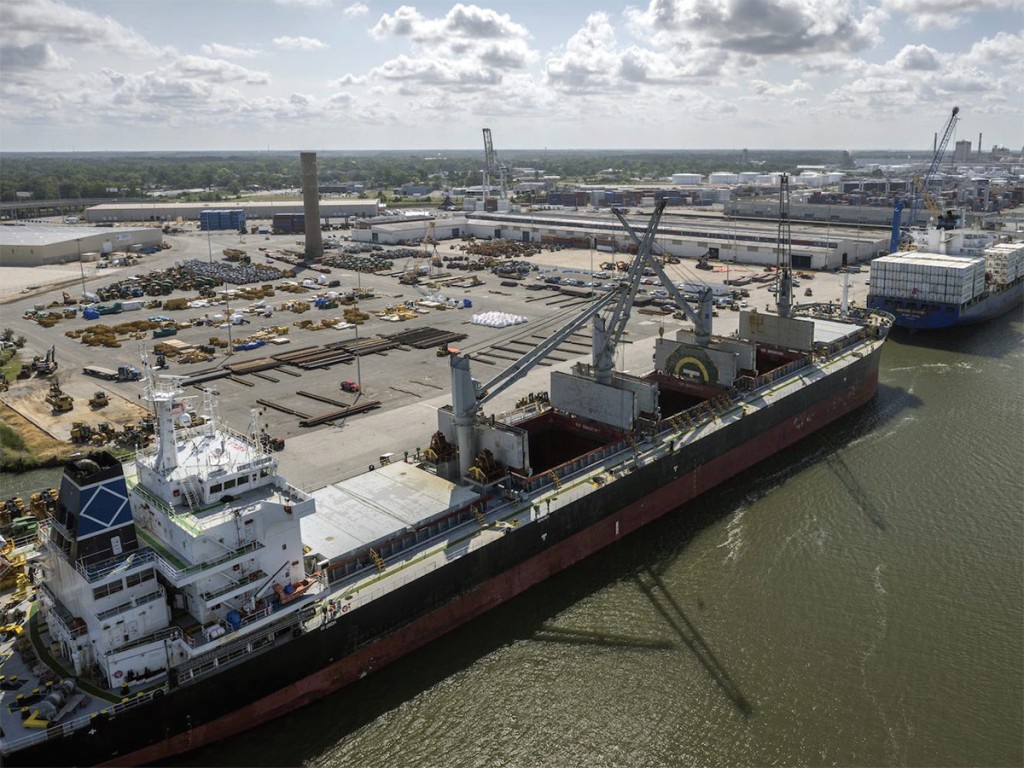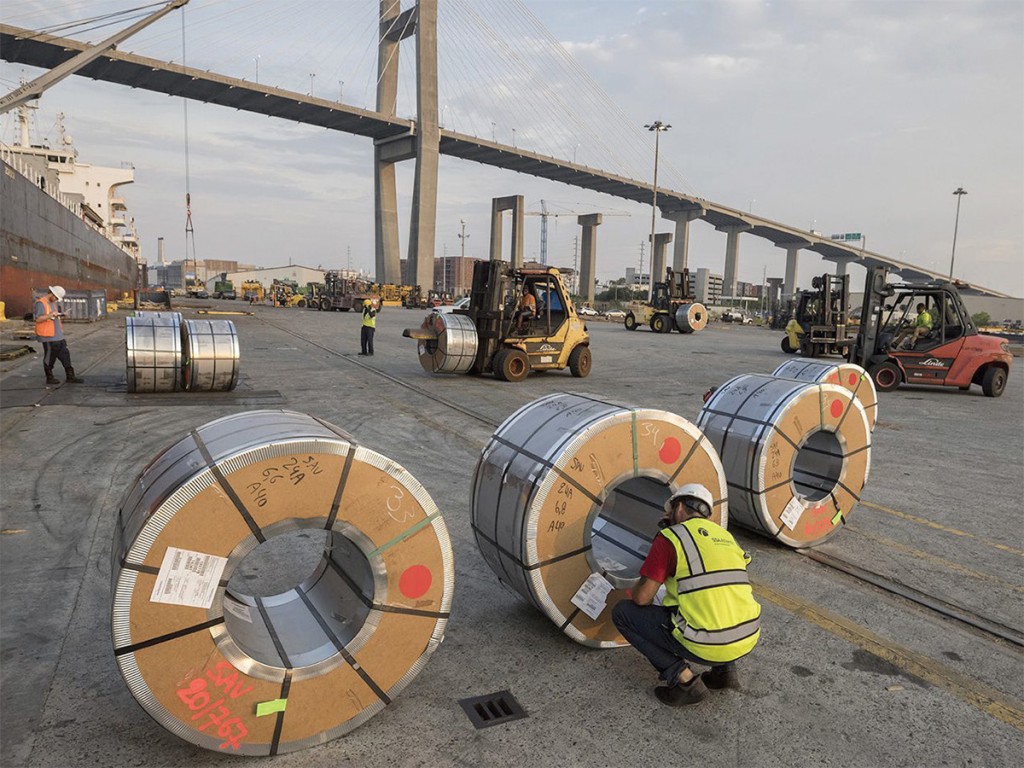Colonial Terminals, Norfolk Southern see a need for additional capacity

Colonial Terminals and Norfolk Southern struck a deal over the summer to develop breakbulk infrastructure along the Savannah River, believing they are filling a breakbulk need created when the Georgia Port Authority converts its Ocean Terminal from breakbulk to container only.
Colonial Terminals, a division of Savannah-based Colonial Group Inc., acquired from Norfolk Southern 16.7 acres of land adjacent to its riverfront facility and NS’s rail facility for US$17 million.
“The cost of the development of the berth will make up (more than one-third) of the overall cost with supporting infrastructure (warehouse, rail, roads, product handling systems, rolling stock, and site development) making up the rest,” said Ryan Chandler, Colonial Terminals’ president.
The first phase includes the development of the berth, refurbishment of an existing warehouse, substantial sitework for rail and roads, as well as product handling systems and rolling stock The second phase will involve the construction of a second warehouse on the newly acquired property, Chandler explained.
While berthing facilities exist at the adjacent site, the new facility would be served by an entirely new berth, he explained. The facility’s capacity will be more than 1 million tons per year.
“Leveraging our strategic infrastructure in partnership with Norfolk Southern to expand our reach into the breakbulk space is a logical next step for our high-service culture,” Chandler said.
“The berth is being constructed with a substantial footprint (wide and deep) to allow for the efficient and safe handling of commodities that may require more space to maneuver to or from a vessel on the dock. The facility will have at least 40 feet of draft, which should accommodate any vessel that calls on the market,” he said.

Celebrating its centennial in 2024, Colonial Terminals started with a 21-acre deepwater terminal on the Savannah River. Focusing originally on petroleum imports and exports, the terminal has branched out into a mixture of liquid bulk and dry bulk products and is now considered the largest independent liquid and dry bulk facility in the U.S. Southeast.
Atlanta-based Norfolk Southern, with 19,335 route miles across 22 eastern U.S. states and Washington, D.C., accesses more than 800 industrial sites and more than 175 general warehouses.
Kathleen Smith, NS vice president of real estate and business development, said NS sees its real estate assets as “a strategic opportunity,” and the partnership with Colonial Terminals “furthers that mission, aligning our organizations to fulfill a critical supply chain need in the Southeast.”
The railroad “anticipates that Colonial Terminal’s new state-of-the-art facility will fill a need” for Savannah’s breakbulk market, said a NS spokesperson.
Chandler agreed that the rail capacity to move products into Norfolk Sothern’s network “will be unparalleled.”
Ocean Terminal Transition
In late 2022, the Georgia Port Authority’s board approved a plan to realign the docks at the Port of Savannah’s Ocean Terminal into an all-container operation to support the port’s burgeoning box business.
The 200-acre Ocean Terminal has operated for more than 40 years, handling a mix of breakbulk and container vessels. Griff Lynch, GPA’s executive director, said most breakbulk cargo will shift to its Port of Brunswick, including breakbulk service provided by Wallenius Wilhelmsen Ocean.
“The Georgia Ports Authority is focused on its two-pillar strategy of specializing on the container business in Savannah and the (roll-on, roll-off) breakbulk business in Brunswick, which is reflected in our investment strategy,” Edward Fulford, manager of media relations at GPA said.

Ocean Terminal continues to handle some breakbulk cargo; the full transition of GPA’s breakbulk volumes to the Port of Brunswick occurs in January 2024. Wharf improvements to handle larger containerships began in January 2023.
Expanding of container operation at Ocean Terminal are expected to take in the entire 200-acre facility,” Fulford said. “Rebuilding the docks will provide 2,800 feet of berth space, capable of serving two big ships simultaneously. Renovations to the first berth will be completed in 2025, with the second completed in 2026. Eight ship-to-shore cranes are destined for Ocean Terminal. By 2026, expanded gates and paving will deliver approximately 2 million TEUs of annual container yard capacity there.”
Construction has started on 360,000 square feet of dockside warehousing to serve the port’s key auto processing, along with three additional buildings and 85 acres of auto storage space on the south side of the island.
In fiscal year 2023 ending June 30, Ocean Terminal handled 2.5 million tons of cargo, of which about 1.1 million tons were breakbulk, and 1.4 million tons were containerized trade (around 136,000 TEUs).

Breakbulk Market Gap
Colonial Terminals’ Chandler says it’s breakbulk expansion is drawing “tremendous interest.” Despite the GPA’s plan to shift breakbulk business to Brunswick, he predicts the GPA’s decision “will leave a product handling gap in the Savannah market that (Colonial’s) facility is ideally suited to fill.”
He insists that Colonial’s move is not to create competition with the GPA. “There are many products that just do not want to leave Savannah, and there are many more products that still want to come. The pie is going to grow, and Colonial is committed to serving this space,” he said.
Those products include steel coils, kraft linerboard, baled wood pulp, lumber, super stacks, structural steel, pipe, and palletized cargo as well as project cargo. “this new facility will be positioned to serve those customers,” he noted.
While GPA’s Fulford expressed confidence that the port authority would retain and grow breakbulk business at the Port of Brunswick, he said: “We see the business Colonial Terminals maintains or brings to Georgia as a win for the state, because it supports jobs and economic development.”
Chandler said the state affords a competitive advantage among U.S. Southeast ports. “There is no stronger or more robust logistical infrastructure in the country than what Savannah offers customers’ supply chains. The state of Georgia is also known to be the best in the nation for doing business. The future of bulk and breakbulk commodities in Savannah is very bright.”
Port of Brunswick Improvements
Meanwhile, the GPA’s Port of Brunswick is in the midst of its own US$262 million in improvements to serve its growing automobile and machinery volumes.
Brunswick is the second-largest U.S. port for import and export or ro/ro cargo, particularly vehicles, behind only the port of Baltimore. Colonel’s Island Terminal handled more than 705,000 units of autos and heavy machinery, an 18 percent increase from fiscal year 2022. During the year the port added Nissan as a Brunswick customer in 2023, handling Nissan imports from Japan and Mexico. CMA-CGM started short-sea service for vehicles between Brunswick in July and Gold Star started a similar Mexico-Breakbulk route in November.
Brunswick will add 640,000 square feet of auto and machinery processing space across five buildings. About 350,000 square feet of near-dock warehousing has already been completed. The port is also developing 122 acres dedicated to roll-on/roll off cargo.
The port authority has also received federal approval to build a fourth ro/ro terminal at Colonel’s Island.
The upgrades will bring the Port of Brunswick’s roll-on/roll-off capacity from 1.2 million to 1.4 million vehicles per year.




